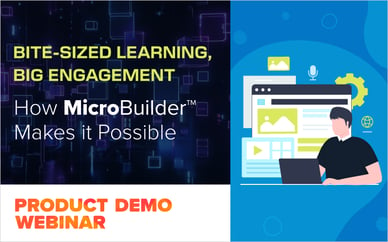This recent webinar provided an in-depth exploration of the differences between Learning Management Systems (LMS) and Learning Experience Platforms (LXP).
Dominic Caloia, Customer Success Manager at ELB Learning, shared criteria organizations can use to make informed decisions when selecting a learning platform that aligns with their unique needs. In this article, we’ll share a high-level summary of these criteria. You can view the recording below for more details.
Learning Platform Selection Criteria
The selection of a learning platform involves more than mere functionality. Here are the key factors discussed during the webinar:
1. Integration Capabilities:
Platforms must integrate seamlessly with existing systems. Tight integration with systems like HR or Salesforce ensures users can access learning without additional logins, thereby promoting ease of use and better adoption rates.
Two levels of integration were highlighted: tight integration within existing systems and single sign-on (SSO), which allows users to automatically log into the learning platform if they are signed into another enterprise system.
2. Goals – Short Term and Long Term:
Organizations should consider both short-term and long-term goals. Short-term goals might include swift deployment within a couple of months and ease of use by a small team.
Long-term goals focus on scalability and future capability requirements. An investment in a comprehensive system now might mean substantial benefits and less hassle as the organization grows and evolves.
3. Team Size and Skill Set:
The size and skills of the Learning and Development (L&D) team play a vital role. For small teams or solo L&D professionals, look for a platform that’s easy to manage without requiring extensive technical knowledge.
For larger teams with diverse skill sets, the platform should allow for advanced features and customizations that can be managed by specialized personnel.
4. Support:
Robust support is critical for successful onboarding and continuous use. Look for vendors that offer dedicated support, comprehensive training, and resources.
Onboarding should be thorough enough to build a strong foundation, with continued support adapted to the team's evolving needs.
5. Benefits and Value:
Evaluate the potential monetary benefits of the platform in terms of time savings, efficiency, and revenue generation.
Consider whether the platform makes learning content creation and management more efficient, thereby cutting down on administrative overhead.
6. Budget:
While often the first consideration, the budget should be reviewed last. After determining the capabilities and how well they align with organizational goals, consider the cost and ROI.
Be open to adjusting the budget if a platform promises substantial long-term benefits over a more affordable but less robustly featured platform.
Evaluating Features and Value
Dominic introduced a methodology for evaluating the features and value of different platforms through worksheets and practical examples:
1. Feature Evaluation:
Create a checklist of essential features, such as SCORM compatibility, content authoring, social learning capabilities, gamification, and multilingual support.
Rate the quality of these features in each platform. For example, not all platforms provide equal quality in gamification or social learning tools.
2. Value Assessment:
Beyond features, assess how these features translate into value for the organization. Will a feature save time, reduce costs, increase learner engagement, or improve training outcomes?
Assign value ratings based on potential savings and benefits. For example, a platform that allows reusing existing content and provides extensive analytics might score high on value.
3. Use Comparative Tools:
Utilize comparative tools like the provided worksheets to assign scores to different platforms based on the aforementioned criteria.
Evaluating the combination of qualitative (how good the features are) and quantitative (the value they bring) assessments can help you make a more informed decision.
In conclusion, selecting the right learning platform involves a multi-faceted analysis that looks beyond initial costs to understand long-term value and alignment with organizational goals. By thoughtfully evaluating features, integration capabilities, team requirements, and support, and balancing these against budget considerations, organizations can find the platform that meets their current needs and supports future growth and adaptability.
Watch the entire LMS vs LXP webinar recording now:







